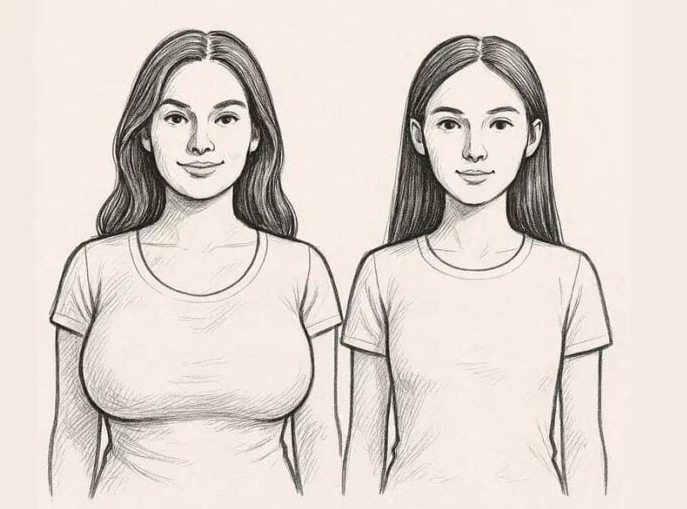For generations, breast size has sparked curiosity, carried cultural meaning, and sometimes created unnecessary worry. Many women, especially as they move gracefully into their sixties, seventies, and beyond, begin to wonder whether the shape or fullness of their breasts reflects something important about their hormones. Some notice gentle changes over the years and seek clarity, while others hear conflicting messages about how body composition relates to lasting vitality.
The truth brings depth, nuance, and genuine reassurance. Breast size arises from a beautiful blend of genetics, hormones, lifestyle, and the natural passage of time. Hormones play their part, yet overall well-being rests on a much wider foundation than cup measurements alone. For women enjoying their golden years, understanding how hormonal harmony, nourishing habits, and supportive practices intertwine with breast health fosters deep confidence and lasting serenity.
This article explores the authentic relationship between breast size and hormonal wellness, gently dispels outdated myths, and shares practical, life-enriching strategies designed specifically for mature women.
The Science Behind Breast Size and How It Evolves
Breast development begins in the early years, guided primarily by genetic heritage and hormonal messages. During puberty, rising levels of estrogen and progesterone stimulate the growth of glandular tissue and supportive fat. By early adulthood, a woman’s natural breast size usually settles into its lifelong pattern.
Life, however, continues to bring gentle shifts, and breast tissue remains beautifully responsive to natural influences across the decades:
- Age naturally adjusts hormone levels, often softening tissue density and firmness in predictable, graceful ways.
- Body weight influences appearance directly because breasts contain a generous amount of fatty tissue; fluctuations in weight naturally reshape contours.
- Daily choices—thoughtful nutrition, regular movement, restorative sleep, and calm stress management—all support hormonal equilibrium and, in turn, breast tissue vitality.
Above all, breast size offers little insight into overall health. Women with smaller breasts possess the same capacity for radiant well-being as women with fuller breasts. Although large population studies sometimes note statistical patterns between body composition and certain conditions, these patterns never dictate individual outcomes.
Clearing Away Common Myths About Breasts and Hormones
Many generations of women have absorbed inaccurate beliefs about their bodies. Here are three widespread myths, accompanied by the clearer, kinder truth they deserve.
Myth 1: Smaller breasts signal hormonal imbalance This idea lacks scientific support. Hormonal health thrives through balanced nutrition, quality sleep, mindful stress care, and consistent self-nurturing—never through cup size alone. Countless women with smaller breasts maintain vibrant hormonal harmony well into their eighties and nineties when they care for themselves with love and intention.
Myth 2: Larger breasts automatically increase serious health risks Some research observes mild statistical links between very large breast size (particularly alongside higher overall body weight) and conditions such as type 2 diabetes or cardiovascular concerns. These findings reflect broad population trends, not personal fate. Active living, nourishing meals, and regular medical check-ups carry far greater influence than measurements alone.
Myth 3: Breast size defines true femininity This remains perhaps the most confining myth of all. Femininity blossoms from inner confidence, warmth, resilience, accumulated wisdom, and the unique way each woman expresses her essence. Physical proportions never determine womanhood. Embracing your body exactly as it appears today unlocks authentic beauty that deepens with every passing year.
Why Hormonal Harmony Matters So Much After 60
Breast appearance may draw the eye, yet hormonal balance shapes daily energy, comfort, and joy. After menopause, naturally lower estrogen and progesterone levels can affect sleep quality, mood stability, bone density, and heart health. Fortunately, loving lifestyle choices support the endocrine system in profound and beautiful ways.
Here are proven, pleasurable ways to nurture hormonal wellness:
- Savor Nutrient-Dense Foods Vibrant vegetables, ripe berries, whole grains, legumes, nuts, seeds, and high-quality proteins supply the exact building blocks hormones require. Foods rich in omega-3s—wild salmon, chia seeds, flaxseeds, and walnuts—gently reduce inflammation and promote hormonal steadiness.
- Move with Pleasure Every Day Regular, enjoyable activity keeps circulation flowing and hormones balanced. Brisk nature walks, gentle swimming, restorative yoga, dance classes, or light strength training all feel wonderful in the sixties and beyond. Movement also supports healthy breast tissue, strengthens bones, elevates mood, and sharpens mental clarity.
- Prioritize Deep Calm and Restorative Sleep Chronic stress elevates cortisol and disturbs estrogen-progesterone harmony. Daily practices—meditation, conscious breathing, gardening, listening to soothing music, or sharing quiet moments with dear friends—restore inner peace and safeguard long-term wellness.
- Consider Gentle, Well-Researched Supplements Certain plant-based helpers have earned centuries of respect for easing women’s hormonal transitions. Evening primrose oil, black cohosh, vitex (chasteberry), red clover, and dong quai belong to the most studied options. Always consult a trusted healthcare provider before introducing new supplements to ensure perfect compatibility with your unique health profile.
Time-Tested Natural Remedies for Everyday Ease
Many women discover comfort and renewed vitality through gentle, traditional remedies that beautifully complement modern habits:
- Sage tea – freshly brewed from premium leaves, sage has accompanied women through hormonal shifts for centuries.
- Maca root – this nourishing Peruvian adaptogen blends smoothly into morning smoothies, offering sustained energy and gentle libido support.
- Ginger or peppermint tea – soothing for digestion and naturally calming, these warm infusions create comforting daily rituals.
These remedies shine brightest when added lovingly alongside balanced meals, joyful movement, and professional medical guidance whenever needed.
Embracing Aging with Grace, Strength, and Deep Self-Love
Changes in breast size and shape unfold naturally over time: skin gradually softens, glandular tissue gently yields to softer fatty tissue, and hormonal rhythms evolve. These shifts mark a life richly lived rather than any form of diminishment.
What truly matters centers on treating your body with steady kindness. Regular activity, nourishing food, peaceful evenings, and meaningful connections all cultivate radiant health that glows from within.
Breast size never measures vitality, worth, or beauty. Hormonal balance, daily self-care, and tender self-acceptance form the true foundation for thriving at every age.
Women over 60 who release old concerns about measurements often step into a liberating new chapter. Energy once spent on comparison now flows freely into cherished hobbies, deepening relationships, adventurous travel, creative pursuits, and quiet moments of heartfelt gratitude.
Your well-being journey honors wholeness rather than numbers on a label. By choosing foods that energize, movement that delights, rest that renews, and remedies that comfort, you create a life brimming with strength, ease, and authentic joy.
Always collaborate with a knowledgeable healthcare provider when making significant changes to diet, exercise, or supplementation. Personalized guidance celebrates the exquisite uniqueness of your body.
At every stage—and especially during these rich, wisdom-filled years—true beauty radiates from a woman who feels fully alive, deeply cherished, and completely at home within herself.





